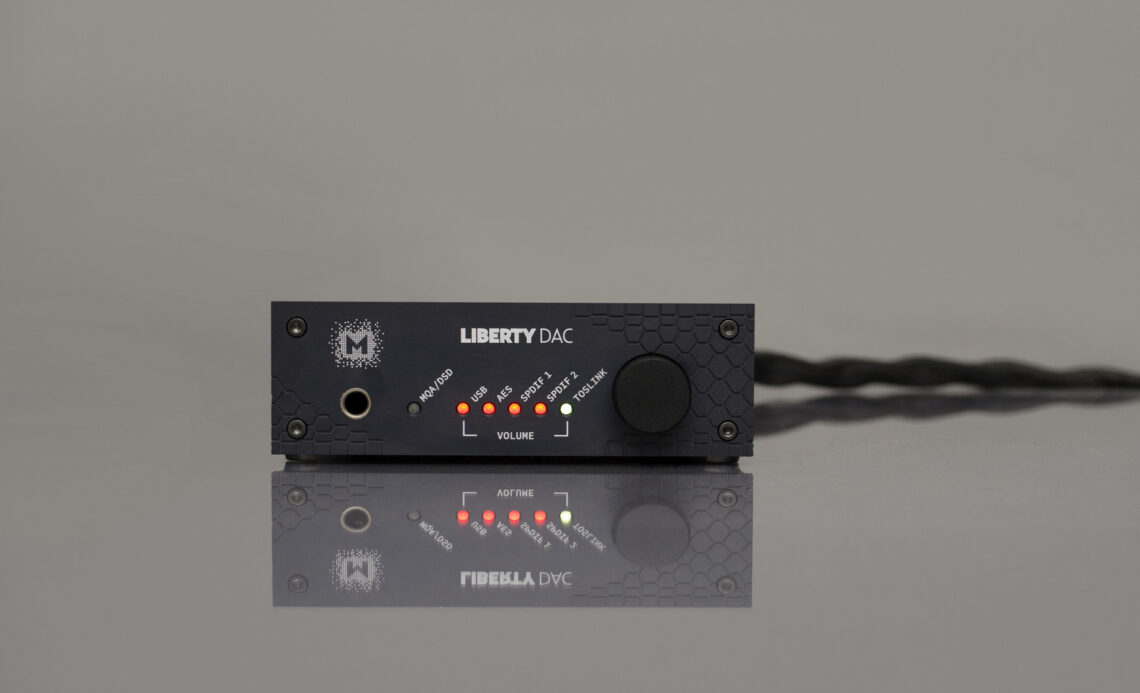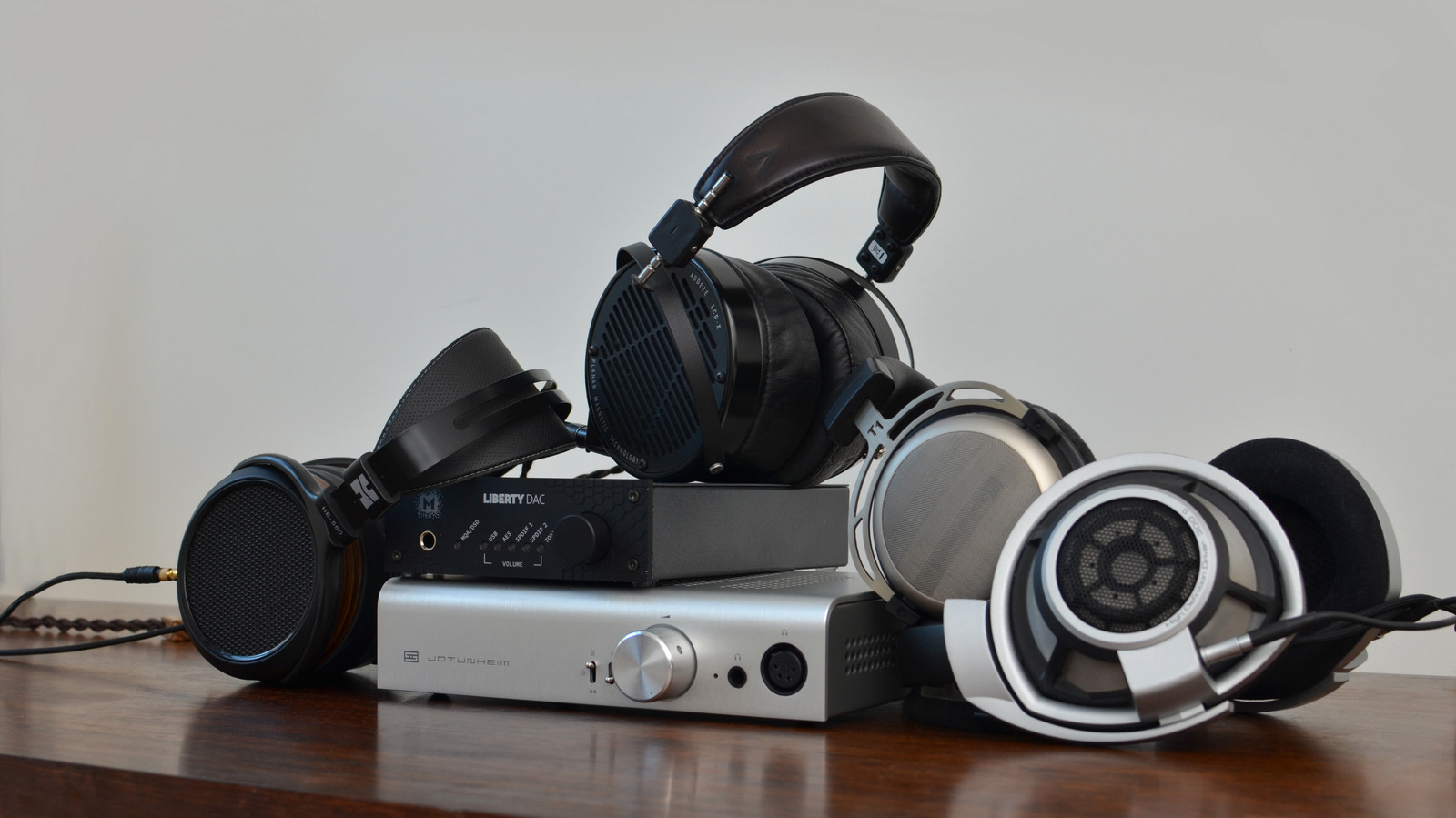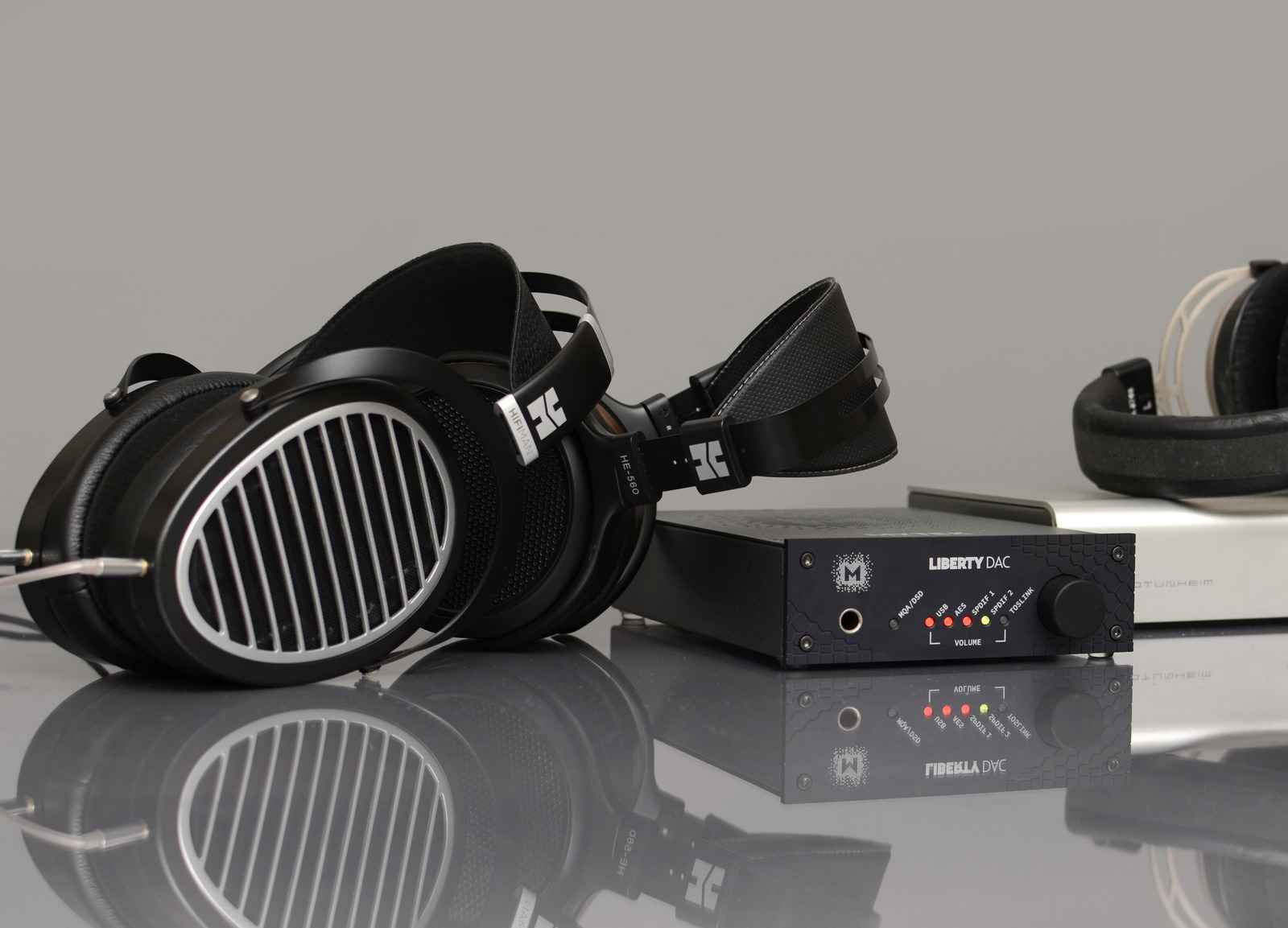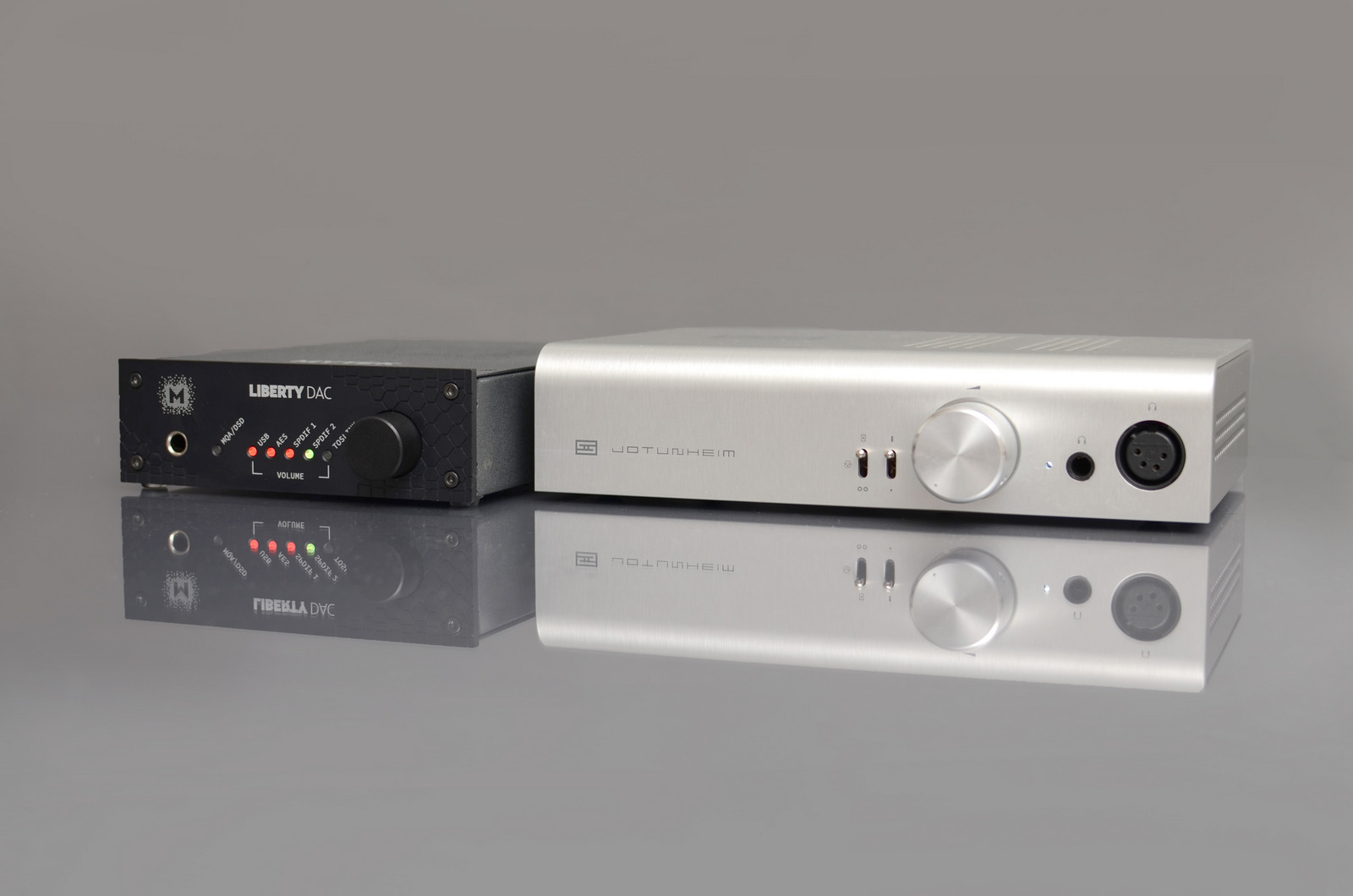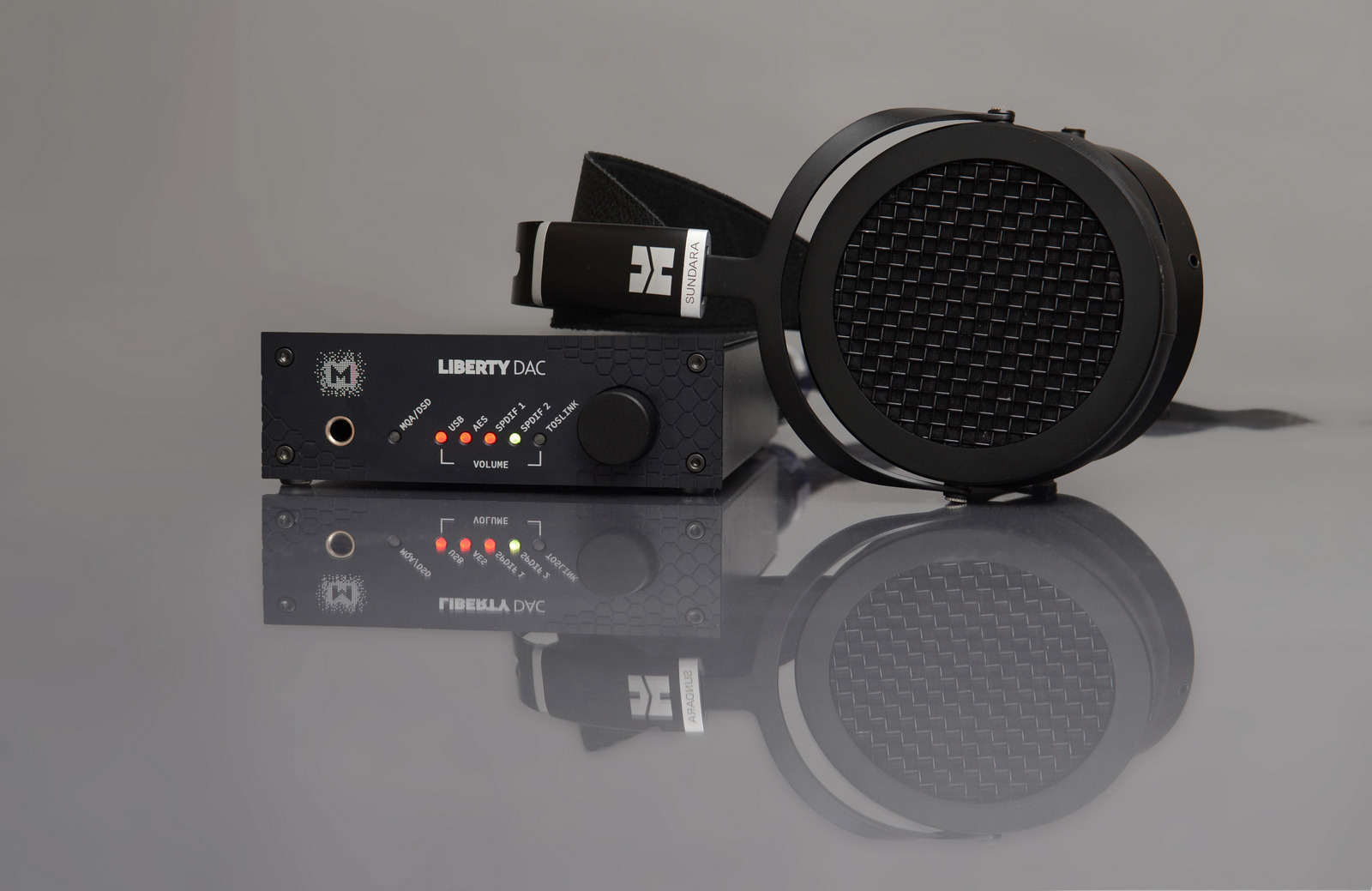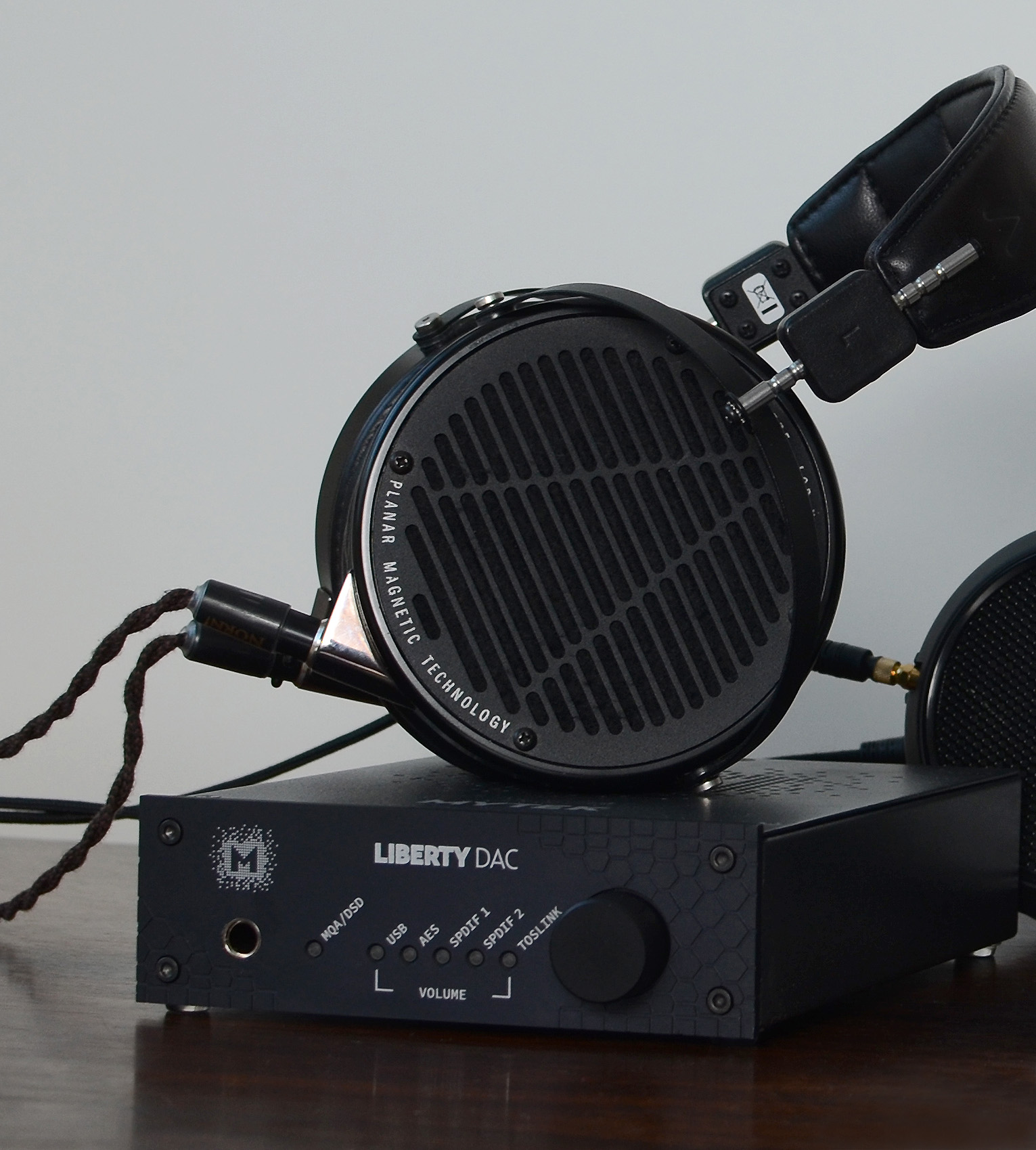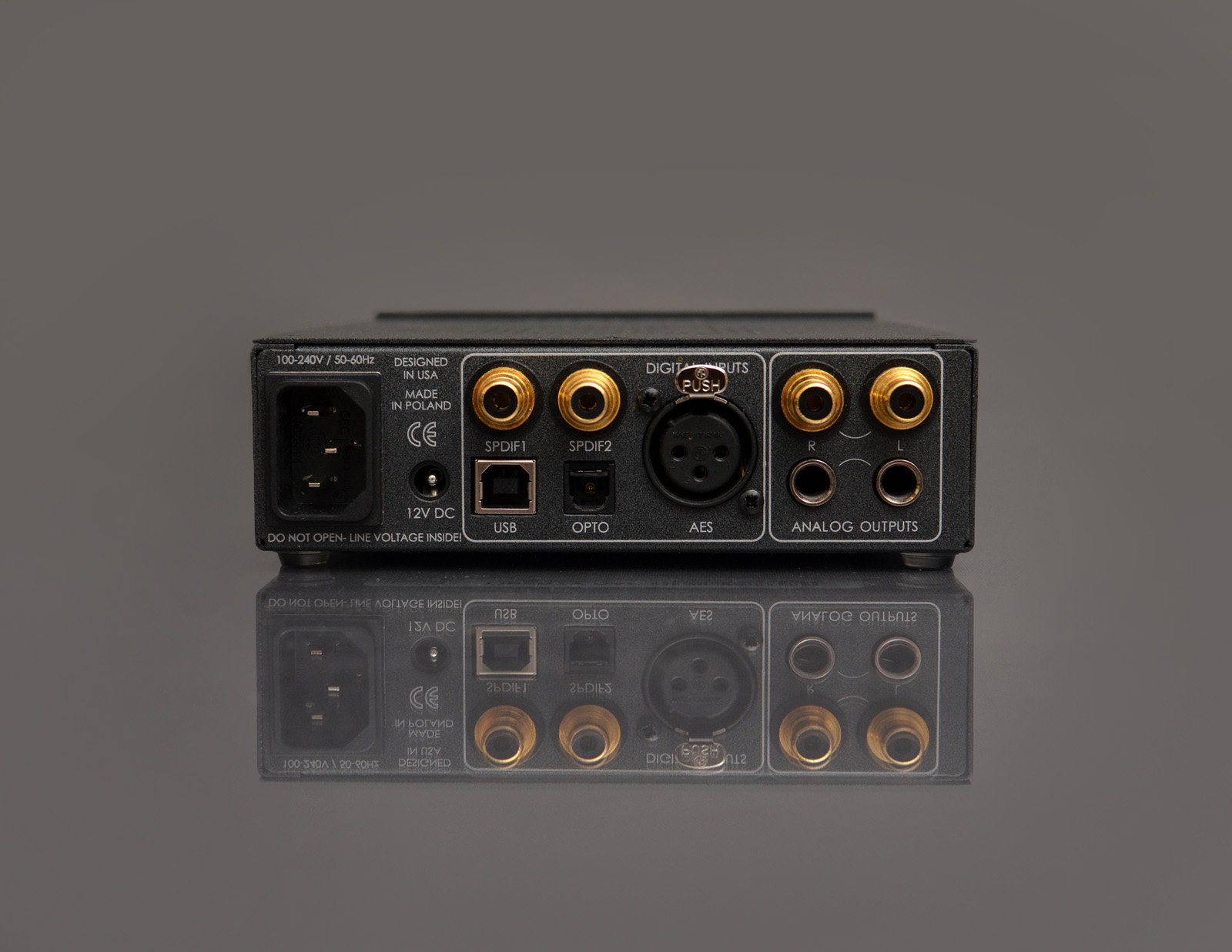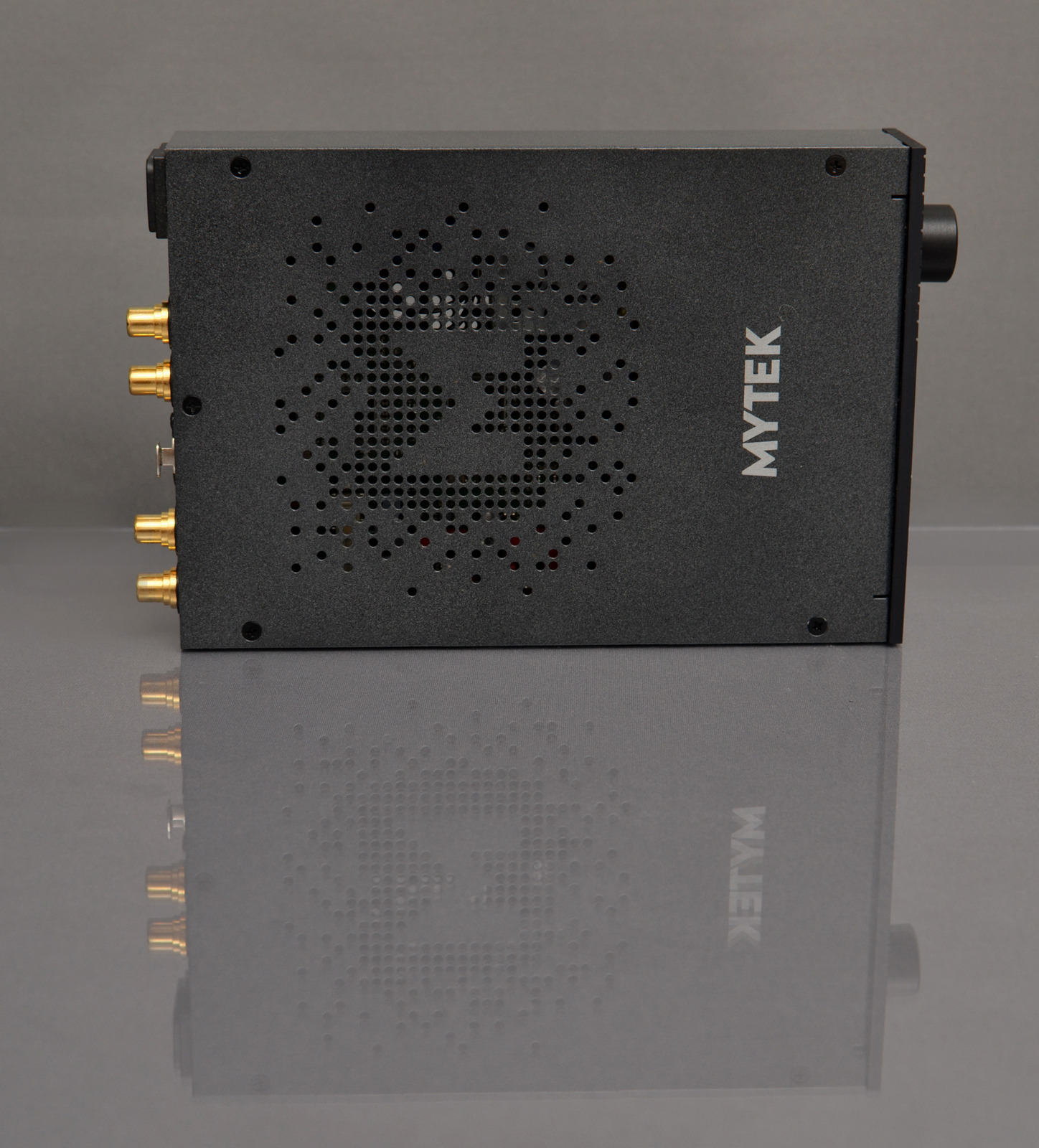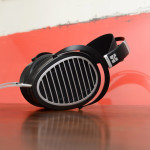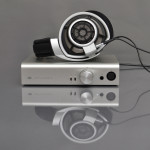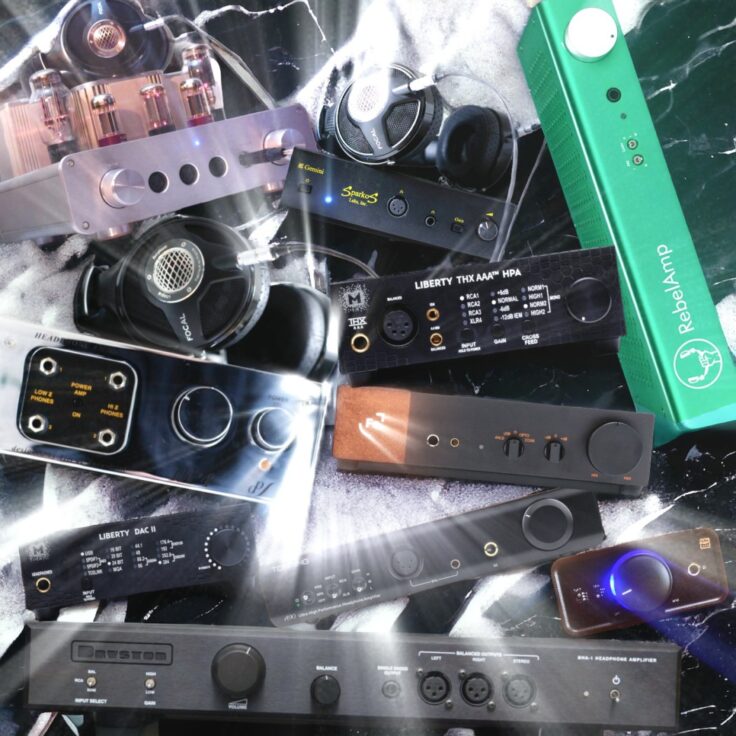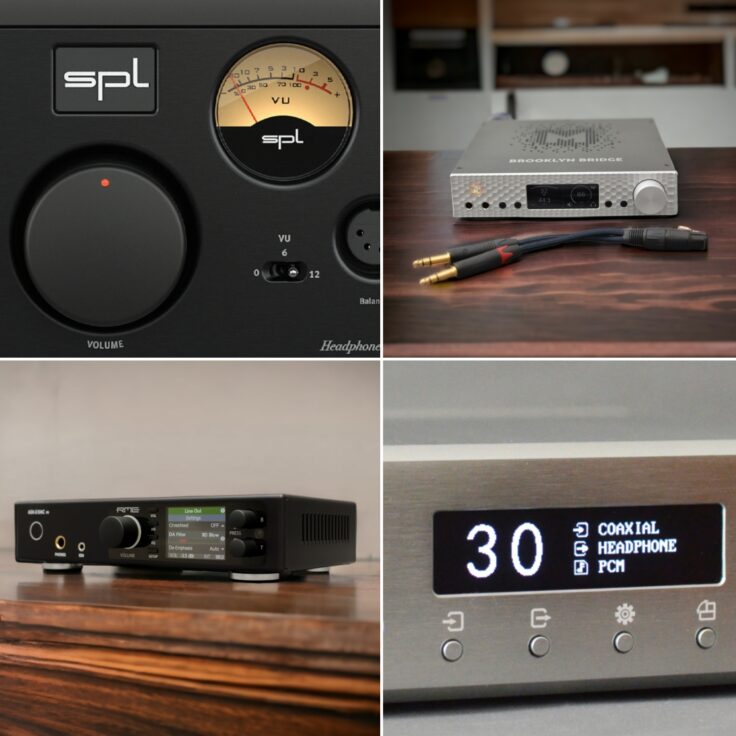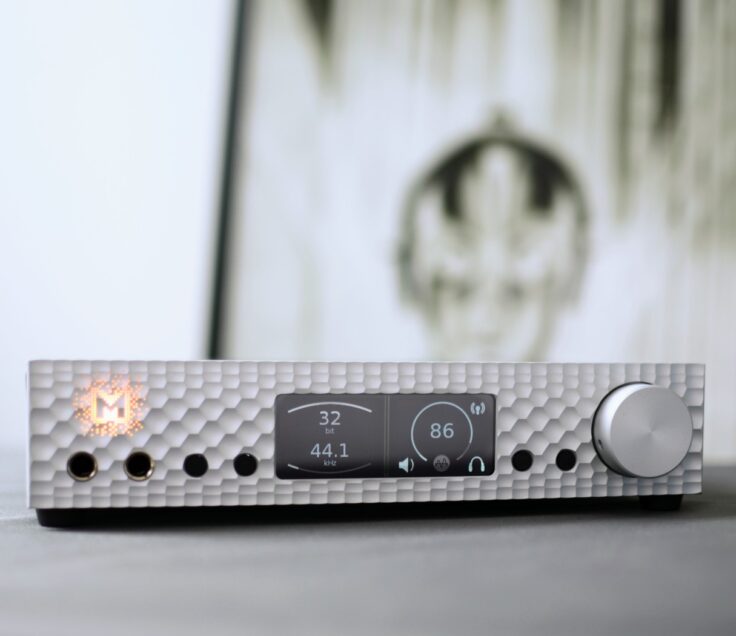The Mytek Liberty DAC is in many ways a stripped down version of the original Mytek Brooklyn DAC. It loses the phono stage, analogue inputs, analogue volume control, display and remote control. It keeps the ES9018 Sabre chipset, the digital inputs, and still houses a digital volume control and headphone amplifier.
As with all Mytek products, the Liberty feels like a professional-grade device. It houses a very busy backplate with a high number of connectivity options. There are four digital inputs: USB, 2 x RCA (S/PDIF) and an optical TOSLINK/ADAT input. The Liberty offers both balanced and unbalanced analog outputs, but the balanced outputs are TRS, not XLR, so most non professional users will need to purchase a pair of TRS-XLR cables. You can buy Mytek´s Metropolis cable, or check out the options from your favorite pro-audio shop. There is a single unbalanced 6.35 mm TRS headphone output on the front. The Liberty is MQA compatible.
Volume Control: There is a digital volume on the Liberty. It cannot be bypassed in other ways than setting the volume to max, and controls the headphone and preamp outputs. The volume control uses the front LED selector lights as an indicator scale. In addition to the 5 LED´s available, Mytek has made them shift colors so that the color gradient of the last LED will indicate if your volume is e.g. 4.1 or 4.6 on the scale. It works very well. There is no remote control option, but Mytek’s PC/Mac software can control the volume via USB.
The quality of the digital attenuation seems to be good, and it worked well with headphones. However, most of them were playing at 4/5 on the LED indicator scale (in other words not too much attenuation going on) and I did (unfortunately) not test it against a high-quality preamp, something that would be interesting for those who want to use the Liberty as a preamp for high end speakers.
Digital Inputs: I tried the Allo USB Bridge Digital Transport, the Allo DIgiOne Digital Transport, and my MacBook Air. Comparing the USB Bridge and the Allo DigiOne, I didn’t really notice any real differences playing the same tracks between the two digital transport devices. Comparing the S/PDIF from the DigiOne to playback from my MacBook Air´s USB output, the MacBook held up quite well. I have heard more difference between these two sources with other DACs, which is a plus for the Liberty´s USB input implementation.
PSU Upgrade Option: The Liberty, as the Brooklyn DACs, can be upgraded with an external 12V power supply. I did not test it on the Liberty, but when I tested the SBooster in my Brooklyn DAC review, there was a small, but audibly positive difference.
DAC/Amp Comparisons
Since the Liberty soon revealed itself as having a quite promising headphone amplifier section, I started off by comparing it to some headphone DAC/Amp competitors.
Liberty vs Violectric V200 + V800
First out is the Violectric V800+V200. It is two separate components, but they are widely known, stack well and a good reference for me. The V800 is not the most recent DAC in the world, but still available from Violectric and still a good DAC. I´ll compare the V800 as a standalone DAC to the Liberty later. But first, here is how I find the Liberty to compare to the Violectric rig as a complete system, which presently would be about twice the cost of the Liberty.
Oppo PM-1
Tomaz Stanko – Faces: The Violectric rig is definitely smoother and punchier. The Brooklyn comes out as a bit harder and brighter sounding.
Young Vivaldi – Concerto in D-minor RV813 Allegro Adagio – Modo Antiquo: Sounding good with the Violectrics, but this time the crisper sounding Liberty gets an extra thumbs up, it feels more revealing, with better texture and a nice little extra bite to those strings.
Midnight City – M83: The Liberty is tighter and cleaner, and is really the winner here.
Audeze LCD-X
Reunion – M83: I feel the Violectric rig has a better grip on the LCD-X here, but not by much.
Who says words with my mouth – Gunhild Seim: The Liberty feels more open and spacious, also with a better sense of detail than the Violectric combo.
Building bridges – Ill Considered: An electric guitar, percussion, and a trumpet. Again, they are on a similar level, but the Liberty certainly has an edge on detail retrieval, especially noticeable in the upper regions.
Sennheiser HD650
Lope – Ill Considered: Quite a bit more snappy feeling with the Liberty. More space and more detail.
Terminal 7 – Tomasz Stanko: Again, I feel the Liberty is a bit more open and presents more detail than the Violectric rig.
Young Vivaldi – Concerto in D-minor RV813 Allegro Adagio – Modo Antiquo: The Liberty sounds really nice, but the Violectric rig feels more full-bodied. The Liberty is a bit thinner, but there is slightly more detail.
Sennheiser HD800
Young Vivaldi – Concerto in D-minor RV813 Allegro Adagio – Modo Antiquo: With the HD800, for which I always found the V200 was a good match, the Liberty cannot really compete. It sounds good, but thinner and less powerful.
Giver – K.Flay: Again, the Liberty is quite a bit thinner sounding. I prefer the extra body offered by the Violectric rig.
Terminal 7 – Tomasz Stanko: This track sounds really nice with the Liberty, lots of space and detail, but the Violectrics gives the HD800 a more natural and pleasant sound.
Concluding, the Liberty is doing a very good job and presents lots of detail and is quite snappy. But it is not as full bodied sounding as the Violectric. How much and if that is a pro or con depends on the headphones I use and the music played. Basically, I suspect, unsurprisingly, that the Liberty is the better DAC, the V200 the better amp. With the exception of the HD800, the Liberty kept up very well to the more than twice as expensive Violectric rig.
DAC/Amp Comparison Liberty vs Schiit Jotunheim Multibit
Moving on to some lower priced competition, the Schiit Jotunheim with the Multibit USB DAC is 25% cheaper than the Liberty. It has only one digital input but includes analog ones. I also hooked up the Auralic Taurus as a headphone amplifier reference.
Hifiman HE560 (balanced cable)
The HE560 is not an easy headphone to drive, but both DAC/Amps manage to give enough oomph to make it sound good. I run the HE560 from the balanced output of the Schiit, which does sound a bit better with the HE560 than the lower power unbalanced output.
The Jotunheim is markedly beefier in its presentation, the Liberty sharper cut, faster and more dynamic. The Liberty especially is very impressive with the HE560. When I run it from the Auralic Taurus in unbalanced mode (using the unbalanced Liberty as a source), I actually to my surprise prefer the Liberty as a standalone DAC/Amp. Using the XLR outputs of the Schiit as a source for the Taurus levels it out, though, not because the Schiit is a better source, but because the Taurus sounds better with balanced inputs, at least in this case. Anyway, the ability to drive the quite hard-to-drive HE560 in such a manner that it almost competes with the massive Taurus, is a big win for the Liberty.
Hifiman Ananda (unbalanced cable)
The Jotunheim and Liberty are both great with the Ananda, and quite similar. With Tomaz Stanko´s “Terminal 7”, the cymbals are a bit crisper with the Liberty, there is a tiny bit more space around instruments, a bit more snappiness. But the difference is not big.
With the Modo Antiquo’’s strings in “The Young Vivaldi”, the Liberty is again crisper, the Schiit has a fuller, slightly less textured presentation. With “Marching Orders” by Led Bib, the bass is powerful with both, but the Liberty feels a tad tighter and cleaner all round. Playing Yazz Ahmed´s “Inspiration, Expiration”, the Liberty is slightly more open, but the rounder feeling of the Jotunheim is not bad either
Generally, the Schiit is good, but less snappy than the Liberty. Thus, I prefer the Liberty with the Ananda. I didn’t get to test the Ananda with the balanced output of the Jotunheim, but the Ananda is not a very heavy load, and since I prefered the HE-560 with the Liberty over the balanced Schiit, I suspect it wouldn’t make much of a difference.
Comparing them both to the Auralic Taurus, they both fall a bit short, the Taurus manages to be combining detail and snappiness with fullness.
Sundara (unbalanced cable)
Unfortunately, I do not have a balanced cable that works with the Sundara either (it has the same cable connectors as the Ananda), Sundara is harder to drive than the Ananda, and could potentially benefit from the higher power balanced output of the Jotunheim. But again, it didn´t shift the tables with the HE560.
The Liberty is better, with more separation, snap and detail. The Jotunheim feels a bit tame in direct comparison. Don´t get me wrong, the Jotunheim is not doing the Sundara injustice, but the Liberty would be my first pick.
Compared to the Taurus, however, the Liberty amp section falls a bit short.
AKG K701
All three amps are doing a good job. Not really much of a difference.
Shure SRH-1840
As with the K701, all are good, not much of a difference.
Sennheiser HD650
All three fares well but the Taurus is a tad better than the Jotunheim, the Jotunheim a tad better than the Liberty.
Audeze LCD-X
The Liberty is tighter and snappier, it feels more precise and dynamic. The Jotunheim (balanced) is great too, with a nice slightly meatier presentation, but not as good as the Liberty.
Compared to the Taurus, they both fall just a tad short. As before, it combines both strengths: It is as full bodied as the Jotunheim, as, precise and dynamic as the Liberty.
Sennheiser HD800
The Jotunheim is a bit fatter and bolder – the Liberty gets a bit thin and sterile, but it is still not bad. Plenty of detail and punch, just lacking a bit with regards to getting the right feel. There is something hyper-realistic about the Liberty which makes it a bit unnatural to my ears.
The Taurus manages to do both things well at the same time, so to speak – and is thus significantly better than both.
Audio Research AR-H1 (unbalanced)
Both do a great job with the AR-H1. The Jotunheim again is a tad fuller than the Liberty, which makes it a slight trade-off. The Taurus opens things up a bit more without losing the full-bodiedness.
Sennheiser HD700 (balanced)
The two DAC/Amps are quite close indeed, but again, the Schiit is a tad fuller in a nice way. The Taurus is a bit better, though.
Beyerdynamic T1 mk2 (balanced)
Again, the Schiit is fuller sounding, the Liberty a bit thin. The Taurus is not a great match for the T1 imo (I find it lacking in body with the 600 ohm T1), and really isn’t any better than the warmer sounding Schiit here, even though there is a trade off between detail and warmth/fullness.
Fostex TH900 (unbalanced)
Both are good, but the Liberty is more dynamic and alive. I don’t really feel the Taurus is any better than the Liberty here, except with regards to hiss: The TH900 is a very sensitive, ow impedance headphone, and there is some unfortunate background hiss with the Liberty/TH900 which for some would be a dealbreaker.
Focal Elear (unbalanced)
Both are great, and immediately quite similar. The Jotunheim is a bit fatter sounding with Smashing Pumpkins “Rocket”, the bassy track “Edmond” by Prins Thomas is a bit more open sounding with the Liberty. The beautiful voice of jazz singer Solveig Slettahjell is a bit more textured with the Liberty.
Moving over to the Taurus I do however notice an improvement, more openness, yet in a fuller and smoother way.
Conclusion
The Liberty is generally snappy and detailed and very likable, but with a few headphones it becomes a bit sterile. I feel the Liberty is at its strongest with planars where it often pulls clearly ahead of the Schiit, which seems to perform a tad better with higher impedance cans and adds more fullness to the sound. A weakness of the Liberty is a noticeable hiss with sensitive low impedance cans, especially the TH900, which was the only one I felt it to be an issue with. The Jotunheim is silent with the headphones I have tested, even with the gain switch set to “high”. I have no nice IEMs to try out, but my Monk earbuds and Momentum headphones are quite silent with the Jotunheim, but is picking up too much hiss from the Liberty.
Liberty DAC Comparisons
Differences between DACs are often subtle compared to those between amplifiers and headphones. Comparing DACs thus often ends up with descriptions that gives the impression of bigger differences than there actually are. Further, whether the differences actually are big enough to matter, depends on the general setup, and to a great extent, the music. That being said, here is how I perceive the Liberty compared to various DACs in various setups, trying to express it in non-exaggerating ways:
Mytek Liberty vs Schiit Jotunheim Multibit – DAC Only
Setup 1: Master 9 amp with HE1000mk2
After a couple of hours of a/b-ing I cannot say that the difference between these are huge. It is actually surprisingly often not easy to tell them apart. But when I do, the Mytek Liberty consistently is better resolved and tends to feel a bit more open, nuanced and relaxed. With the “Young Vivaldi” album by Ensemble Modo Antiquo, the Liberty has a gentler presentation, it feels smoother and has less edgy sounding strings. With “Pantha Du Prince” by The Bell Laboratory, the Liberty feels a bit clearer and more open.
Setup 2 Leben CS300XS with Ananda and Sundara
With the Hifiman Ananda, I tend to find the Liberty a tad clearer and more sparkling, but sometimes have to listen very hard to find the differences. Switching to the less resolving Hifiman Sundara headphone, I simply cannot tell them apart.
Mytek Liberty vs Audio-gd Master 7
The Audio-gd Master 7 is my best DAC. It is a highly regarded, 15 kg, 8 x PCM1704 DAC-chip monster.
Setup 1: Stax SR-009/SRM-007tII
On my most resolving setup, I am surprised how little difference I can tell with most music. After several tracks of little to write about, I finally find a guitar intro that makes the two DACs really stand apart: “Can´t See You” by Susan Wong. Here suddenly there were some “in your face” differences. Most strikingly, the Master 7 has more of a fullness and roundness to it, the Liberty (as the Brooklyn DAC), has a crisper, but slightly thinner sound.
Going through some more music, I find the general impression that the Liberty is a little bit thinner and drier sounding, the Master 7 fatter and bolder. Although detail level definitely is in the same ballpark, the Master 7 feels to have better articulation, in other words that it feels more distinct in a more pronounced way, like if the details have a bit more weight.
Setup 2: Audio-gd Master 9 amp and HD800/HE1000v2
First, I must say that they both sound very good. However, I tend to find the Master 7 again a bit more articulated and sometimes a bit more alive sounding. I notice that the Liberty has some of that same brittleness to its tone that I remember from the Mytek Brooklyn DAC.
Setup 3: Leben CS300XS amp with HE560 and HE1000mk2
As with the previous setups, I found the Master 7 to be a tad bolder, slightly more articulated and dynamic in its rendering, but they are not far apart.
Conclusion: Liberty vs Master 7
I have a weak spot for the Master 7´s presentation. There is, after all, a reason I have it in my system. But the Liberty is great. For most setups, I really didn’t prefer the one over the other. When I found them noticeably different, they were both very nice – but in slightly different ways.
Even though these DACs are of very different designs, what comes out is more similar than different. Good DACs should sound similar. Detail level is close enough to not be an issue for me. The slight differences in the presentation, the feeling, that’s where the battle is.
Given the advantages in price and size, I am really impressed with the Liberty and also pleased that the tonality is not too far off from my beloved Master 7. I found similar results when testing the Brooklyn last year, but from memory the Liberty seems to be a tad warmer in its presentation. Even though I do not have the Brooklyn here now, I cannot believe anything except they are very close in performance. Which sort of makes the Liberty a small bargain.
Mytek Liberty vs Violectric V800
When comparing the Liberty to the Master 7, I found the Liberty to be a bit thin sounding. Compared to the V800 however, it is the other way around. Playing “Surrey With The Fringe on Top” by Emilie Claire Barlow on the Hifiman HE560 and the Audio-gd Master 9 amp, the Liberty is definitely the bold one of the two DACs. We´re talking subtle differences here, but the Liberty is, without doubt, a tad more bold in the mids than the V800. All in all, I find the tonality of the Liberty to be slightly warmer than the V800, but it shares some of that nice Violectric smoothness. They are in the same ballpark with regards to detail retrieval – but the Liberty sometimes feels a bit clearer.
Mytek Liberty vs Hegel HD25
I also bring out the Hegel HD25 and compare it to the Liberty. They are not very dissimilar, but I find the Liberty a tad cleaner and the Hegel a tad thicker sounding.
DAC Comparisons Concluded
Broadly speaking, all the DACs compared here are good. But there are differences, and the Liberty compares favorably. It does not dethorne my Master 7, which still has a tad more articulation and that precious musical boldness. Compared to the other well regarded and more expensive (albeit a bit older) DACs, the Liberty is a winner, cleaner than the Hegel, more musical sounding than the Violectric.
Amplifier Comparison
I didn’t set it to be a priority to compare the Liberty to a range of standalone headphone amplifiers, but aside from the above DAC/Amp comparisons, I did some quick listening with two amps in quite different price classes.
Mytek Liberty vs Schiit Asgard 2
Basically I found the Liberty better with AR-H1, LCD-X, K701, and Elear. Mostly because the Liberty is tighter and cleaner. The Asgard has more fullness, but at the cost of detail. With HD650 they are more equal. The takeaway, however, is the Liberty is not lost at all against a budget headphone amplifier, I´d choose it over the Asgard 2 for many headphones.
Liberty vs Woo WA22
I have enjoyed the Hifiman Sundara with the Liberty a lot. But the WA22 packs more slam and warmth, it is more organic and spacious. So the Sundara does indeed grow with better amplification. Moving over to the Ananda there is less difference between the Brooklyn and the WA22. The most obvious difference between the two is that the Liberty has a bit drier sound, but is still very pleasing. Honestly, though I’m not sure the difference in performance is close to defending the price jump. This says a lot, because I found the WA22 really, really good with the Ananda in my Ananda review. That does not mean they are equal, but the Liberty really is a great performer.
Headphone Matching
Based on my testing, it is clear that getting the best out of your Liberty´s headphone output requires some matching for optimal results. I found it remarkably good with planar magnetic headphones, especially the Hifiman Ananda. But the Sundara, HE-560, LCD-X, LCD-3, AR-H1 and Oppo PM1 all perform very well. Lower impedance dynamic headphones like the K701 are also good, as long as they are not too sensitive like the TH900, which sounds good but gives you an audible background hiss. This was the case with the Brooklyn too, and I wish Mytek would make a gain-switch on the next Liberty, similar to that of the Manhattan II.
With high impedance headphones the Liberty was often good, but not as remarkable as with the above-mentioned planars. I found Beyerdynamic T1 mk2 and the Sennheiser HD800 to sound detailed and sharp, but lacking too much in tonal weight and body. So, if you own a Liberty, be sure to let it play with a planar magnetic headphone. It will make them both happy.
Main Conclusion
The Liberty is a great little DAC. It is clear and transparent with a hint of warmth. I never found it too dry or clinical sounding. Most of all it feels neutral, clear and smooth. Connectivity and functionality are very impressive for such a small box. I´ve been impressed with previous DACs from Mytek, and considering the price, Liberty might be the most impressive so far.
The built in headphone amplifier is powerful, punchy, crisp and clear. It is especially impressive with planar magnetic headphones. With very sensitive headphones there is an issue with low level hiss, and with a few headphones, it might lack a bit warmth and fullness. With those exceptions, and with almost all headphones tested, I find the headphone output to sound really, really good.
I think the Liberty could be worth the asking price even without the headphone output, first of all because of its great sound and competitive price tag, but also because of the functionality and MQA support. That Mytek includes a headphone output that drives my planars so good that it gives some of my quite expensive amps real competition, was a very pleasant surprise.
MANUFACTURER SPECIFICATIONS :
CONVERSION: Up to 384k, 32bit PCM, native DSD up to DSD256, DXD, 127dB Dynamic Range
MQA HI-RES DECODER: built in certified hardware MQA™ decoder
DIGITAL INPUTS: USB2 Class2 (OSX, Linux driverless, all formats), AES/EBU (PCM up to 192k, up to DSD64 DOP), 2x S/PDIF (PCM up to 192k, up to DSD64 DOP), Toslink/ADAT 2x S/PDIF (PCM up to 192k, up to DSD64 DOP)
ANALOG OUTPUTS: 1 pair of unbalanced RCA, 1 pair of balance TRS, TRS To XLR Metropolis Cable can be added as option
HEADPHONE AMPLIFIER: Reference High Current, High transient Headphone Amp, 300mA, 3 Watts, single unbalanced headphone jack, designed to drive hard to drive headphones, 0.1 Ohm impedance
CLOCK GENERATOR: Low noise with 10ps of jitter
FIRMWARE: Upgradable via USB via Mytek Control panel
OPTIONAL DC/BATTERY POWER INPUT: 12VDC
DIMENSIONS: WxDxH=5.5×8.5×1.74”=140x216x44mm
WEIGHT: 3lbs, 1.5kg
WARRANTY: 2 years
Manual (pdf download from Mytek) here


